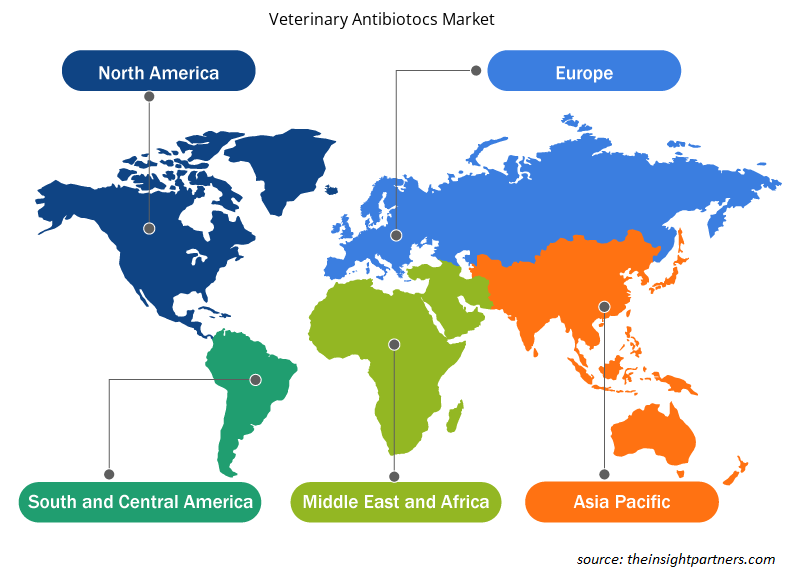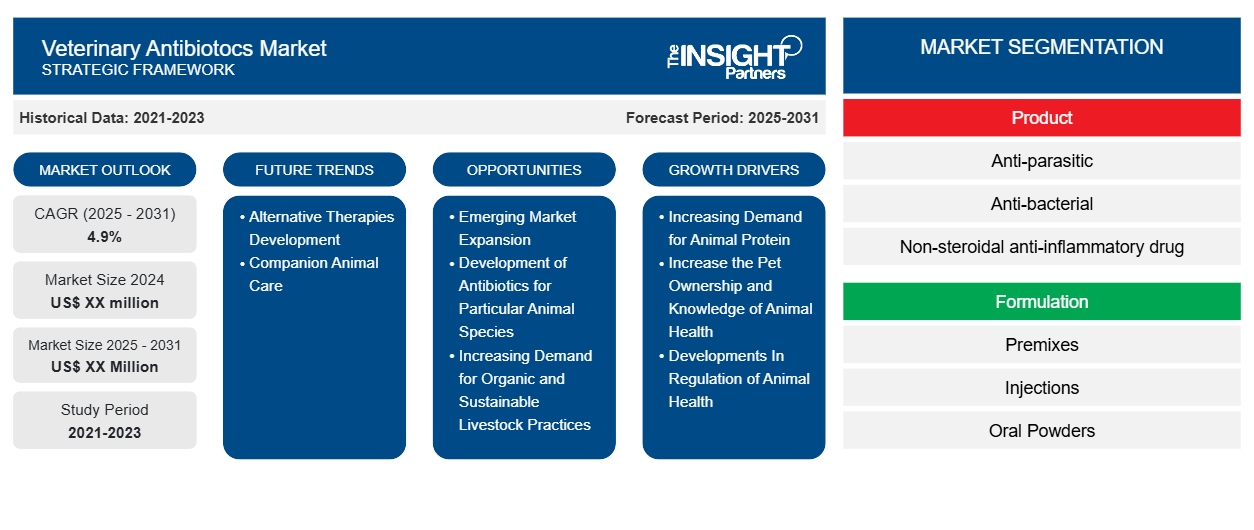من المتوقع أن يسجل سوق المضادات الحيوية البيطرية معدل نمو سنوي مركب بنسبة 4.9٪ من عام 2023 إلى عام 2031، مع توسع حجم السوق من XX مليون دولار أمريكي في عام 2023 إلى XX مليون دولار أمريكي بحلول عام 2031.
يقدم التقرير تحليلاً يعتمد على المنتج (مضاد للطفيليات ومضاد للبكتيريا ومضاد للالتهابات غير الستيرويدية وغيرها) ؛ التركيبة (الخلطات المسبقة والحقن والمساحيق الفموية والمحاليل الفموية وغيرها) ؛ الاستخدام النهائي (حيوانات المزرعة والحيوانات الأليفة وغيرها). يتم تقسيم التحليل العالمي بشكل أكبر على المستوى الإقليمي والدول الرئيسية. يتم تغطية حجم السوق والتوقعات على المستويات العالمية والإقليمية والقطرية لجميع قطاعات السوق الرئيسية ضمن النطاق. يقدم التقرير القيمة بالدولار الأمريكي للتحليل والقطاعات المذكورة أعلاه. يقدم التقرير إحصائيات رئيسية عن حالة السوق للاعبين الرئيسيين في السوق ويعرض اتجاهات السوق والفرص.
غرض التقرير
يهدف تقرير سوق المضادات الحيوية البيطرية الصادر عن The Insight Partners إلى وصف المشهد الحالي والنمو المستقبلي وأهم العوامل الدافعة والتحديات والفرص. سيوفر هذا رؤى لمختلف أصحاب المصلحة في الأعمال التجارية، مثل:
- مزودي/مصنعي التكنولوجيا: لفهم ديناميكيات السوق المتطورة ومعرفة فرص النمو المحتملة، وتمكينهم من اتخاذ قرارات استراتيجية مستنيرة.
- المستثمرون: إجراء تحليل شامل للاتجاهات فيما يتعلق بمعدل نمو السوق، وتوقعات السوق المالية، والفرص المتاحة عبر سلسلة القيمة.
- الهيئات التنظيمية: لتنظيم السياسات ومراقبة الأنشطة في السوق بهدف تقليل الانتهاكات والحفاظ على ثقة المستثمرين والحفاظ على سلامة السوق واستقرارها.
تجزئة سوق المضادات الحيوية البيطرية
منتج
- مضاد للطفيليات
- مضاد للبكتيريا
- دواء مضاد للالتهابات غير الستيرويدية
- آحرون
صياغة
- الخلطات المسبقة
- الحقن
- مساحيق فموية
- الحلول الفموية
- آحرون
الاستخدام النهائي
- حيوانات المزرعة
- الحيوانات الأليفة
- آحرون
الجغرافيا
- أمريكا الشمالية
- أوروبا
- آسيا والمحيط الهادئ
- أمريكا الجنوبية والوسطى
- الشرق الأوسط وأفريقيا
الجغرافيا
- أمريكا الشمالية
- أوروبا
- آسيا والمحيط الهادئ
- أمريكا الجنوبية والوسطى
- الشرق الأوسط وأفريقيا
قم بتخصيص هذا التقرير ليناسب متطلباتك
ستحصل على تخصيص لأي تقرير - مجانًا - بما في ذلك أجزاء من هذا التقرير، أو تحليل على مستوى الدولة، وحزمة بيانات Excel، بالإضافة إلى الاستفادة من العروض والخصومات الرائعة للشركات الناشئة والجامعات
- احصل على أهم اتجاهات السوق الرئيسية لهذا التقرير.ستتضمن هذه العينة المجانية تحليلاً للبيانات، بدءًا من اتجاهات السوق وحتى التقديرات والتوقعات.
محركات نمو سوق المضادات الحيوية البيطرية
- الطلب المتزايد على البروتين الحيواني: إن سوق المضادات الحيوية البيطرية النامية هي نتيجة لتغير تفضيلات المستهلكين للمنتجات الحيوانية - أعلى بكثير من أدنى لزيادة هذا الاستهلاك - لزيادة الاستهلاك - للحوم ومنتجات اللحوم جنبًا إلى جنب مع منتجات الحليب أو البيض. تم تطوير إنتاج الثروة الحيوانية لتلبية طلب المستهلكين من خلال إدخال المضادات الحيوية، حيث يكون الوقاية من العدوى أو علاجها في إنتاج الثروة الحيوانية صحيًا ويجعل إنتاج الثروة الحيوانية أكثر إنتاجية. هذا هو أحد التطورات التي تدفع الطلب على المضادات الحيوية في تربية الحيوانات والسوق بشكل كبير.
- زيادة ملكية الحيوانات الأليفة ومعرفة صحة الحيوان: إن زيادة ملكية الحيوانات الأليفة والوعي بصحة الحيوانات في جميع أنحاء العالم من بين المحركات الرئيسية القوية لسوق المضادات الحيوية البيطرية. يتم تعزيز الإنفاق على صحة الحيوانات الأليفة وتشجيعه من خلال البحث في علاج الحيوانات الأليفة واستخدام المضادات الحيوية. لقد خلقت ظاهرة الناس تجاه حيواناتهم الأليفة - وبالتالي إضفاء الطابع الإنساني على حيواناتهم الأليفة من خلال زرع رفاهيتهم في المقدمة - اتجاهًا آخر في توسيع سوق المضادات الحيوية البيطرية.
- التطورات في تنظيم صحة الحيوان: إن تطوير المعايير كقواعد تنظيمية جيدة لصحة الحيوان في جميع أنحاء العالم يتم تحديثه. والآن في ظل هذه التطورات يسعى الناس إلى تحسين الإدارة أو الرعاية الوقائية للماشية. وهذا هو ما سيجعل الناس يستخدمون المضادات الحيوية البيطرية عندما أصبحت تدابير التحكم في الأمراض التي تصيب الحيوانات والاستخدام الآمن للمضادات الحيوية من قبل المزارعين أمرًا شائعًا. وبالتالي فإن كل الجوانب المذكورة أعلاه ستشعل حاجة السوق إلى أدوية المضادات الحيوية المناسبة.
الاتجاهات المستقبلية لسوق المضادات الحيوية البيطرية
- تطوير العلاجات البديلة: يتم علاج العدوى في الحيوانات باستخدام العلاجات البديلة منذ أن أصبح القلق المتزايد بشأن مقاومة المضادات الحيوية يؤثر بشكل متزايد على نظام العلاج. وتشمل البدائل الأكثر رسوخًا التي تدخل حيز التنفيذ البروبيوتيك واللقاحات والمواد المضافة للأعلاف النباتية بدلاً من المضادات الحيوية. وقد أظهر التطور في هذا التغيير أن السوق يتغير فيما يتعلق بصحة الحيوان مع اتباع نهج شامل ومستدام بدلاً من الاستخدام المعتمد للمضادات الحيوية في الممارسة البيطرية.
- رعاية الحيوانات الأليفة: تشهد صحة الحيوانات الأليفة أيضًا زيادة في الطلب على المضادات الحيوية البيطرية. ومع تحسن ملكية الحيوانات الأليفة بشكل كبير خلال العقد الماضي، إلى جانب زيادة الإنفاق على الرعاية الصحية للحيوانات الأليفة، فمن المتوقع أن ينشأ المزيد من الطلب على المضادات الحيوية لعلاج الالتهابات بين الكلاب والقطط والحيوانات الأليفة الأخرى. وبالتالي، يضيف هذا إلى حجم سوق المضادات الحيوية البيطرية، وخاصة في المناطق المتقدمة.
فرص سوق المضادات الحيوية البيطرية
- التوسع في الأسواق الناشئة: يبدو سوق المضادات الحيوية البيطرية واعدًا في الدول الناشئة مع استمرار زيادة عدد السكان والطلب على البروتين الحيواني، وازدهار تربية الماشية. إن إنشاء بنية تحتية محسنة لصحة الحيوان وزيادة الوعي بالرعاية البيطرية يوفر العديد من الفرص العظيمة للآفاق في هذه الأسواق. يمكن للشركات أن تأخذ هذا إلى أبعد من ذلك وتوفر المضادات الحيوية الرخيصة وسهلة الوصول لتلبية الاحتياجات المتزايدة في الرعاية الصحية الحيوانية الفعالة.
- تطوير المضادات الحيوية لأنواع معينة من الحيوانات: هناك احتمالات ضئيلة بأن يتم تطوير المضادات الحيوية البيطرية المحددة لأنواع معينة من الحيوانات فقط والتي تستهدف تلك المشاكل الصحية الفريدة. وقد تشمل هذه المضادات الحيوية المضادات الحيوية الخاصة بالدواجن أو الماشية أو الحيوانات الأليفة والتي تتميز بأنماط مرضية متباينة. إن معالجة نوع واحد فقط من الأنواع من شأنه أن يسمح لشركة الأدوية بالتعامل مع المتطلبات المتنوعة المتعلقة بمزارعي الحيوانات وحتى أصحاب الحيوانات الأليفة، مما يؤدي إلى تطوير الأعمال وتوسيع نطاق تنوع منتجاتها.
- الطلب المتزايد على ممارسات تربية الماشية العضوية والمستدامة: يخلق الاتجاه المتزايد باستمرار نحو الزراعة العضوية والمستدامة فرصًا جديدة في مجال المضادات الحيوية البيطرية. ومع مطالبة المستهلكين والمزارعين على حد سواء بأن تكون منتجاتهم خالية من أي مواد كيميائية ومضادات حيوية ضارة، هناك أيضًا مجال لإصدار شهادات عضوية لمضاد حيوي معين أو تحويله لتلبية متطلبات معايير الاستدامة الأكثر صرامة. يلبي هذا الاتجاه البيئة التنظيمية مع الإضافة إلى سوق الأغذية العضوية المتنامية.
رؤى إقليمية حول سوق المضادات الحيوية البيطرية
لقد قام المحللون في Insight Partners بشرح الاتجاهات والعوامل الإقليمية المؤثرة على سوق المضادات الحيوية البيطرية طوال فترة التوقعات بشكل شامل. يناقش هذا القسم أيضًا قطاعات سوق المضادات الحيوية البيطرية والجغرافيا في جميع أنحاء أمريكا الشمالية وأوروبا ومنطقة آسيا والمحيط الهادئ والشرق الأوسط وأفريقيا وأمريكا الجنوبية والوسطى.

- احصل على البيانات الإقليمية المحددة لسوق المضادات الحيوية البيطرية
نطاق تقرير سوق المضادات الحيوية البيطرية
| سمة التقرير | تفاصيل |
|---|---|
| حجم السوق في عام 2023 | XX مليون دولار أمريكي |
| حجم السوق بحلول عام 2031 | XX مليون دولار أمريكي |
| معدل النمو السنوي المركب العالمي (2023 - 2031) | 4.9% |
| البيانات التاريخية | 2021-2022 |
| فترة التنبؤ | 2024-2031 |
| القطاعات المغطاة | حسب المنتج
|
| المناطق والدول المغطاة | أمريكا الشمالية
|
| قادة السوق وملفات تعريف الشركات الرئيسية |
|
كثافة اللاعبين في سوق المضادات الحيوية البيطرية: فهم تأثيرها على ديناميكيات الأعمال
يشهد سوق المضادات الحيوية البيطرية نموًا سريعًا، مدفوعًا بالطلب المتزايد من المستخدم النهائي بسبب عوامل مثل تفضيلات المستهلكين المتطورة والتقدم التكنولوجي والوعي المتزايد بفوائد المنتج. ومع ارتفاع الطلب، تعمل الشركات على توسيع عروضها والابتكار لتلبية احتياجات المستهلكين والاستفادة من الاتجاهات الناشئة، مما يؤدي إلى زيادة نمو السوق.
تشير كثافة اللاعبين في السوق إلى توزيع الشركات أو المؤسسات العاملة في سوق أو صناعة معينة. وهي تشير إلى عدد المنافسين (اللاعبين في السوق) الموجودين في مساحة سوق معينة نسبة إلى حجمها أو قيمتها السوقية الإجمالية.
الشركات الرئيسية العاملة في سوق المضادات الحيوية البيطرية هي:
- زويتيس، المحدودة
- شركة ميرك وشركاه
- شركة باير ايه جي.
- سانوفي
- ايلي ليلي
إخلاء المسؤولية : الشركات المذكورة أعلاه ليست مرتبة بأي ترتيب معين.

- احصل على نظرة عامة على أهم اللاعبين الرئيسيين في سوق المضادات الحيوية البيطرية
نقاط البيع الرئيسية
- التغطية الشاملة: يغطي التقرير بشكل شامل تحليل المنتجات والخدمات والأنواع والمستخدمين النهائيين لسوق المضادات الحيوية البيطرية، مما يوفر صورة شاملة.
- تحليل الخبراء: تم تجميع التقرير على أساس الفهم العميق لخبراء الصناعة والمحللين.
- معلومات محدثة: يضمن التقرير أهمية الأعمال التجارية بسبب تغطيته للمعلومات الحديثة واتجاهات البيانات.
- خيارات التخصيص: يمكن تخصيص هذا التقرير لتلبية متطلبات العملاء المحددة وبما يتناسب مع استراتيجيات العمل بشكل مناسب.
وبالتالي، يمكن أن يساعد تقرير البحث حول سوق المضادات الحيوية البيطرية في تمهيد الطريق لفك شفرة وفهم سيناريو الصناعة وآفاق النمو. ورغم وجود بعض المخاوف المشروعة، فإن الفوائد الإجمالية لهذا التقرير تميل إلى التفوق على العيوب.
- التحليل التاريخي (سنتان)، سنة الأساس، التوقعات (7 سنوات) مع معدل النمو السنوي المركب
- تحليل PEST و SWOT
- حجم السوق والقيمة / الحجم - عالمي، إقليمي، بلد
- الصناعة والمنافسة
- مجموعة بيانات إكسل
التقارير الحديثة
تقارير ذات صلة
شهادات العملاء
سبب الشراء
- اتخاذ قرارات مدروسة
- فهم ديناميكيات السوق
- تحليل المنافسة
- رؤى العملاء
- توقعات السوق
- تخفيف المخاطر
- التخطيط الاستراتيجي
- مبررات الاستثمار
- تحديد الأسواق الناشئة
- تحسين استراتيجيات التسويق
- تعزيز الكفاءة التشغيلية
- مواكبة التوجهات التنظيمية





















 احصل على عينة مجانية ل - سوق المضادات الحيوية البيطرية
احصل على عينة مجانية ل - سوق المضادات الحيوية البيطرية